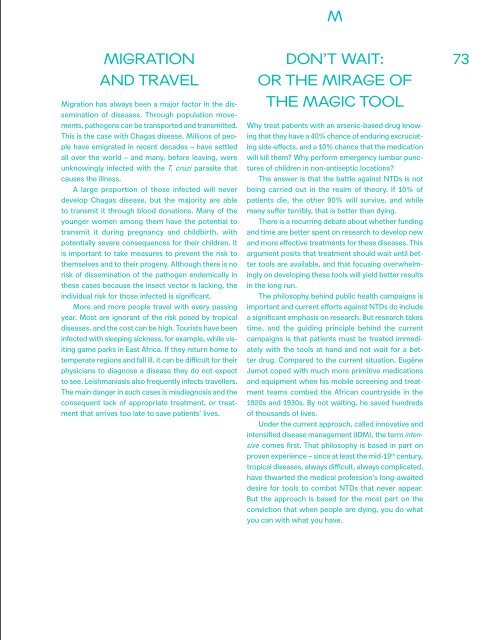You also want an ePaper? Increase the reach of your titles
YUMPU automatically turns print PDFs into web optimized ePapers that Google loves.
M<br />
MIGRATION<br />
AND TRAVEL<br />
Migration has always been a major factor in the dissemination<br />
of diseases. Through population movements,<br />
pathogens can be transported and transmitted.<br />
This is the case with Chagas disease. Millions of people<br />
have emigrated in recent decades – have settled<br />
all over the world – and many, before leaving, were<br />
unknowingly infected with the T. cruzi parasite that<br />
causes the illness.<br />
A large proportion of those infected will never<br />
develop Chagas disease, but the majority are able<br />
to transmit it through blood donations. Many of the<br />
younger women among them have the potential to<br />
transmit it during pregnancy and childbirth, with<br />
potentially severe consequences for their children. It<br />
is important to take measures to prevent the risk to<br />
themselves and to their progeny. Although there is no<br />
risk of dissemination of the pathogen endemically in<br />
these cases because the insect vector is lacking, the<br />
individual risk for those infected is significant.<br />
More and more people travel with every passing<br />
year. Most are ignorant of the risk posed by tropical<br />
diseases, and the cost can be high. Tourists have been<br />
infected with sleeping sickness, for example, while visiting<br />
game parks in East Africa. If they return home to<br />
temperate regions and fall ill, it can be difficult for their<br />
physicians to diagnose a disease they do not expect<br />
to see. Leishmaniasis also frequently infects travellers.<br />
The main danger in such cases is misdiagnosis and the<br />
consequent lack of appropriate treatment, or treatment<br />
that arrives too late to save patients’ lives.<br />
DON’T WAIT:<br />
OR <strong>THE</strong> MIRAGE OF<br />
<strong>THE</strong> MAGIC TOOL<br />
Why treat patients with an arsenic-based drug knowing<br />
that they have a 40% chance of enduring excruciating<br />
side-effects, and a 10% chance that the medication<br />
will kill them? Why perform emergency lumbar punctures<br />
of children in non-antiseptic locations?<br />
The answer is that the battle against NTDs is not<br />
being carried out in the realm of theory. If 10% of<br />
patients die, the other 90% will survive, and while<br />
many suffer terribly, that is better than dying.<br />
There is a recurring debate about whether funding<br />
and time are better spent on research to develop new<br />
and more effective treatments for these diseases. This<br />
argument posits that treatment should wait until better<br />
tools are available, and that focusing overwhelmingly<br />
on developing these tools will yield better results<br />
in the long run.<br />
The philosophy behind public health campaigns is<br />
important and current efforts against NTDs do include<br />
a significant emphasis on research. But research takes<br />
time, and the guiding principle behind the current<br />
campaigns is that patients must be treated immediately<br />
with the tools at hand and not wait for a better<br />
drug. Compared to the current situation, Eugène<br />
Jamot coped with much more primitive medications<br />
and equipment when his mobile screening and treatment<br />
teams combed the African countryside in the<br />
1920s and 1930s. By not waiting, he saved hundreds<br />
of thousands of lives.<br />
Under the current approach, called innovative and<br />
intensified disease management (IDM), the term intensive<br />
comes first. That philosophy is based in part on<br />
proven experience – since at least the mid-19 th century,<br />
tropical diseases, always difficult, always complicated,<br />
have thwarted the medical profession’s long-awaited<br />
desire for tools to combat NTDs that never appear.<br />
But the approach is based for the most part on the<br />
conviction that when people are dying, you do what<br />
you can with what you have.<br />
73


